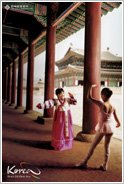How do Koreans represent themselves? Modernity v. Traditionalism
The aphorism, “a picture is worth a thousand words,” is appropriate especially pertaining to the visual representation of a nation, its populace, terrain, and culture. Illustrations employed as advertisements are one of the most significant illustrations of a nation, which Professor Kim Young-Hoon accurately highlights “the important point is not to focus on how the images or identity of Korean culture have been formulated from the outside but to examine the methods Korea, exercising its own agency, has employed in shaping it” (83). For this reason, my review will be based on the November 2003 selected image portraying South Korea in four aspects: traditional life, modern times, people, and nature. In addition, it must be noted that most tour pictures incorporate some aspect of traditions and modernity alongside each other, which symbolizes the merging of the past and present creating a unique visual focusing on Korean life. Tradition is significant in defining a culture, especially Korea’s, since its customs are distinctive although most classify “Korean culture in comparison to China and Japan” (Kim 86). Modernization is creating uniformity through skyscrapers, multi-billion dollar franchises such as McDonalds, and the like while limiting culture to museums. Minus topography, large urban areas have similar if not identical aspects globally, which is the reason national identity is dependent and grounded so strongly on history.
Below are photographs recently printed for tourist purposes. Both employ similar marketing techniques such as the theme of traditional verses contemporary as well as displacement of traditionalism within the modern atmosphere (right image) and vice versa in the left visual. In addition, both inject a sense of “exoticism”, a lacking in the foreigner’s culture that he or she can idealize but cannot fully comprehend. In other words, “making the familiar unfamiliar, and the unfamiliar familiar” (Auerbach 5). Beginning with dissecting the image of Seoul’s topography on the right, the first impression that is taken away is the centrality of religiously life in Korea. Vegetation surrounds the temple grounds while the background above and below is painted with modernity, a metropolis. However, the eyes are drawn to a representation of East Asian culture through the visual focusing on a temple, which is exoticized from its atypical components especially in American culture. The lushness of the trees and the almost simulated-looking blueness of the sky are essential to drawing upon the opposing themes of a tranquil traditional paradise and modern essentials for daily life. Thus, Korea in this visual represents an escape from reality while still having the ability to still step back into an urban setting.
The left visual accomplishes the same effects however, modernity and tradition switch roles. The setting is a temple, which represents not only East Asian rituals but also traditional history. The photograph appears more like an image from the early twentieth century instead of contemporary with dull but blending colors unlike the left image. Unlike the first image which focuses on traditionalism at the center of a modern environment, this photography draws on the differing roles of the two young girls, one a traditional dancer the other a modern performer. However, the ballerina is displaced into a traditional setting, which limits her qualities of modern expansion or so it would be perceived. The main question is “which girl is influencing the other’s dance?”, or more importantly “which child is mimicking the other child’s life?” This inquiry is essential for answering the debate of which is the predominant overtone in this advertisement: modernity or traditionalism. The slogan at the lower left corner “where old meets new” perhaps suggests the seeping of modern influence into Korean traditional culture, but I believe the visual is purposely ambiguous to allow the viewer the opportunity to decide for oneself and perhaps establish that Korea is unique in being simultaneously traditional and modern. Both visual representations are highly effective in drawing tourism to Korea through showing its exclusive aspect of being both a modern and traditional country to reach a larger audience.


 (EB)
(EB)pictures on http://english.tour2korea.com/07T2KZone/KoreaInImages/poster.asp?kosm=m7_4&konum=3

0 Comments:
Post a Comment
<< Home